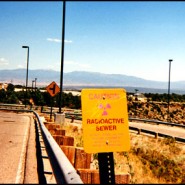June 08, 2009
By: John
Category: radiation myths & misconceptions, video
[reprinted from nullsession.net]
Radiation is natural, yet the very word itself generates an irrational fear in most people. Why? Nuclear science is still a relatively young science, and people picture exploding atom bombs when they think of radiation. They think of Three-Mile Island and Chernobyl and a thermonuclear holocaust. Yet, as this BBC documentary points out, this fear is not rational and often it is the fear of radiation that causes psychological trauma.
Radiation is all around us. In nature, something is either matter or radiation. Electromagnetic radiation includes radio waves, microwaves, infrared, visible light, ultraviolet light, x-rays and gamma rays. We are submerged in an ocean of radiation fields. Energetic charged particles are also all around us, from the breakdown of heavier elements, yet most do us no harm at all. There are four tons of uranium in the top foot of every square mile of land. People live in regions with higher background radiation than the well-known reactor accident caused in the Russian city of Chernobyl, and they thrive. Some even suspect, as I have suggested before, that some level of background radiation is important to the stimulation of the body’s immune system. read more
Comment (1)
June 08, 2009
By: John
Category: radiation safety

Safe Containment
The container, called Transuranic Packaging Transporter Model 2, or TRUPACT-II, is:
- Eight feet in diameter and 10 feet high.
- Doubly-contained, non-vented, and constructed of stainless steel.
- Certified by the Nuclear Regulatory Commission and meets U.S. Department of Transportation safety requirements.
A series of stringent tests conducted on the container included:
- A drop from a height of 30 feet onto an unyielding surface.
- Exposure to jet fuel fire at a temperature of 1,475 degrees Fahrenheit for a minimum of 30 minutes.
- A drop onto a steel spike from 40 inches to test puncture resistance.
The tests showed that the container would hold its seal and prevent release of radioactivity to the atmosphere.
Safe Storage at WIPP
Why Salt?
Let’s look at storage at the WIPP facility in New Mexico, as an example.
Government officials and scientists chose the Waste Isolation Pilot Plant (WIPP) site through a selection process that started in the 1950s. At that time, the National Academy of Sciences conducted a nationwide search for geological formations stable enough to contain wastes for thousands of years. In 1955, after extensive study, salt deposits were recommended as a promising medium for the disposal of radioactive waste. Since then, bedded salt has been one of the leading candidates for the permanent disposal of radioactive waste. read more
Comments Off on Safe Storage of Transuranic Waste


 Dr. John D. Johnson has a background in nuclear, experimental & accelerator physics. He worked for Los Alamos National Laboratory in the 1990s and founded Docent Institute to raise awareness about the ethical use of advanced technology.
Dr. John D. Johnson has a background in nuclear, experimental & accelerator physics. He worked for Los Alamos National Laboratory in the 1990s and founded Docent Institute to raise awareness about the ethical use of advanced technology.